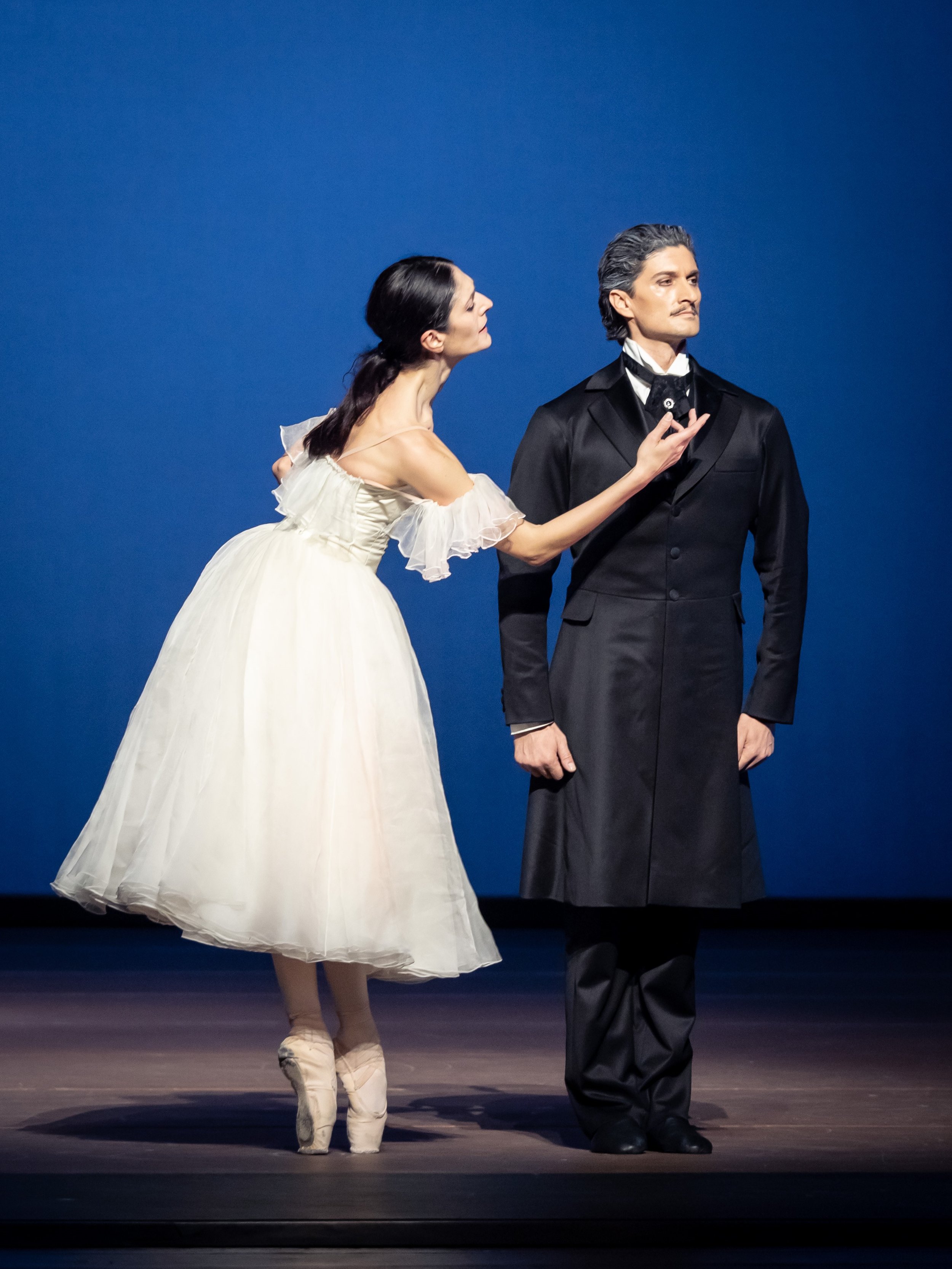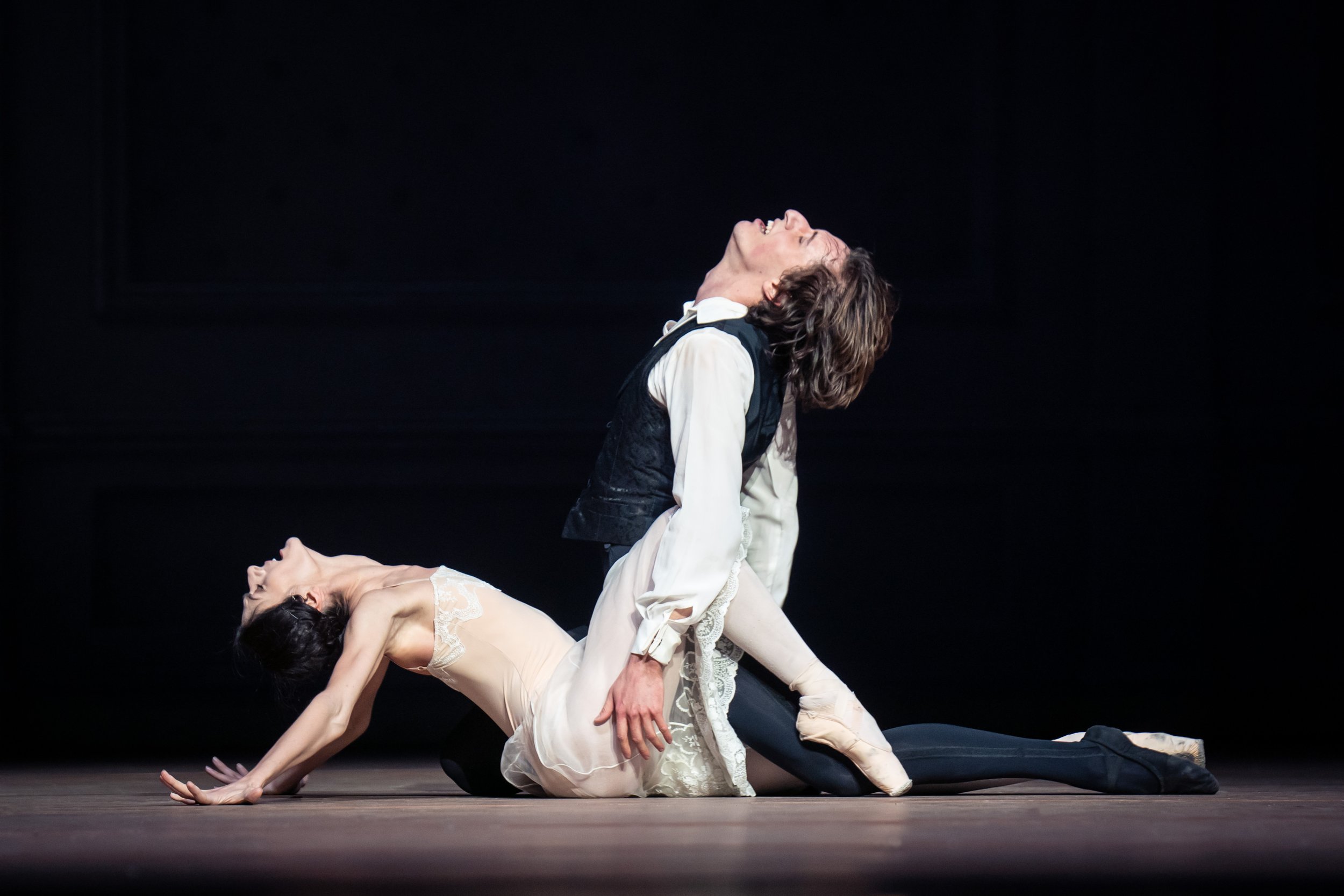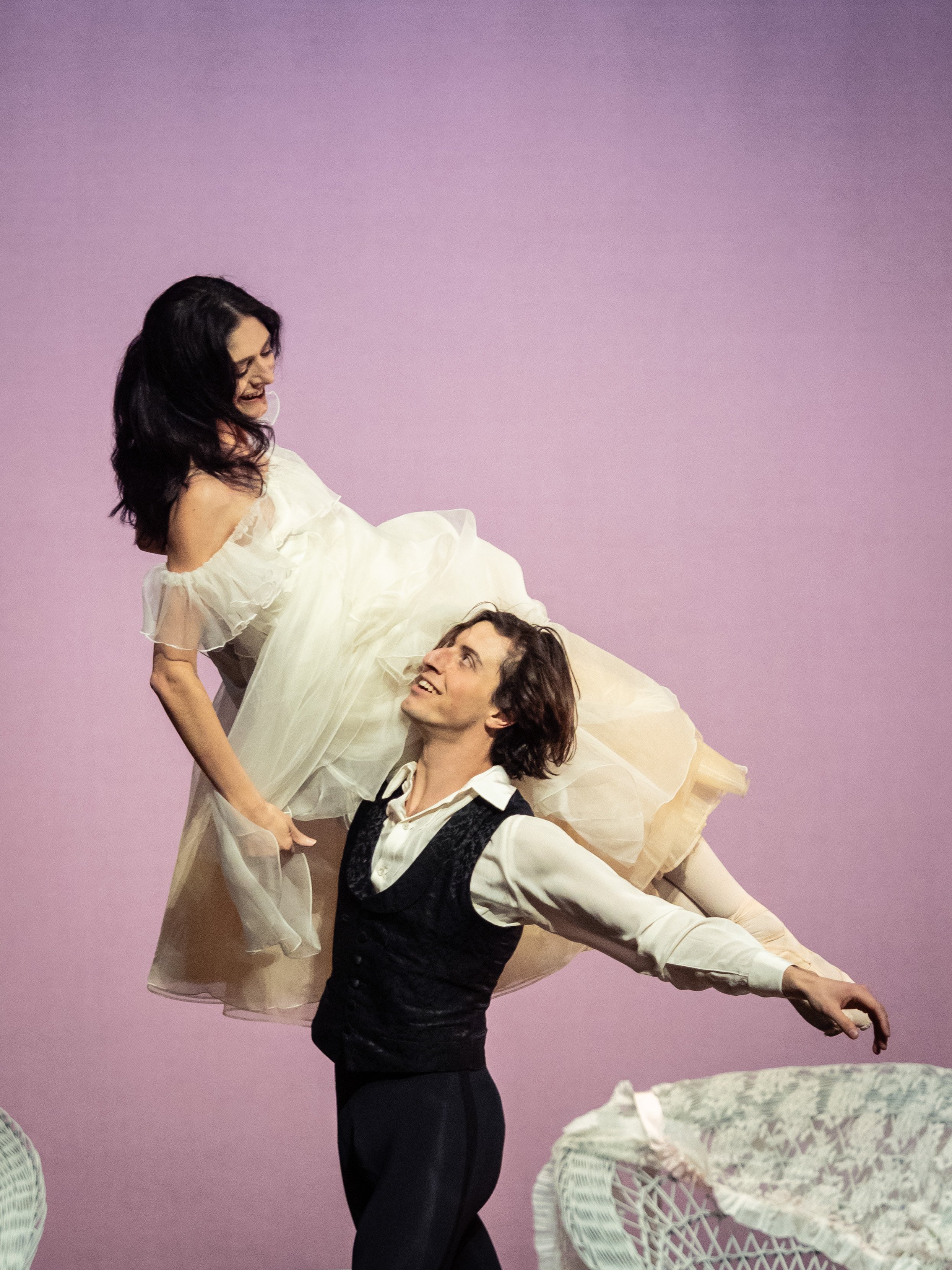"La Dame aux Camélias" (Die Kameliendame), Première. Vienna State Ballet (Wiener Staatsballett), March 24th, 2024.
La Dame aux Camélias (Die Kameliendame), Première. Vienna State Ballet (Wiener Staatsballett), March 24th, 2024.
After what seemed to be a very long Interval, there was – at last again – a certain excitement „in the air" at the Opera House yesterday evening.
A „classic" (written by John Neumeier in 1978 for The Stuttgart Ballet and Marcia Haydée), a great production with scenery and costumes by Jürgen Rose, the eternal music from Frédéric Chopin, the touchingly tragic story by Alexandre Dumas Jr. and the brilliant dramaturgical treatment given personally by the choreographer himself, compose what is sometimes considered to be John Neumeier's greatest work. I tend to agree with that.
Copyright: Ricardo Leitner / attitude
There is no question that John Neumeier's „La Dame aux Camélias" belongs to the category of the great Ballet masterpieces written in the late 20th century, not only choreographically but also dramaturgically. It has the distinction of being perhaps the only ballet that will inspire you to go as soon as possible to the next bookshop and buy „Prévost's „Manon Lescaut" to understand even more intrinsically the connections of the ballet/play to the „play within a play", a technique created by Shakespeare, or should we call it „Ballet within Ballet"?
This work of genius and its brilliant treatment of „time" mixed with phantasy, as the „use" of figures as Manon and Des Grieux together with the „main couple" (Marguerite and Armand) will create. multiple situations in which pas de deux, pas de trois and pas de quatres will take place. Situations which will define the characters even more distinctively to the audiences – from Marguerite Gautier's ambitions to possess money and jewels power and from her questioning about true love until the „last" pas de trois, in which Des Grieux is carrying a dying Manon (and Marguerite) through the New Orlean's swamps – wasn't it mentioned on her diary how „lucky" Manon was to at least die with her beloved one while she...
John Neumeier takes Alaia Rogers (Corps de Ballet) by the hand to show her a detail. Love and care for every detail… this photo shows it! Copyright: Marian Furnica Photography
The storyline is told (interpreted, understood) by different people: Armand, Monsieur Duvall and even Marguerite „via" her diary. Such a brilliant concept, originated solely by Mr Neumeier without any help of a „dramaturge" (In the theatre, a dramaturge is someone who "helps" the director interpret the text of the play and whose work is completely unnecessary and irrelevant if the "director" understands his work in the way Mr Neumeier masters his). And this is what I most admire: A creator who is responsible for the different aspects of the production. From A to Z. From the conception to the „Birth" of the piece and even now, supervising the staging of the whole production and still making changes which have „ripened" in his mind with the passing of time. Mr B. did the same. That is why such pieces are still „alive" and will continue to be so until the day the creator is not anymore among us and "a last", definite version of it is "frozen". But that is another Story.
The main question for the Ballet Connoisseurs was „Will the Ensemble be able to do it, technically? Will it be able to live up to the general expectations?"
As you may remember, I wrote in my last „Don Quixote" review, while commenting on basic principles of the classical dance, that the Corps de Ballet was technically „in real trouble".
More about that later.
Copyright: Vienna State Ballet/ Ashley Taylor
It had been quite a long time since I had last seen this wonderful work.
The last performance of „La Dame" that I had visited, dates back to March 31st, 2007, as Alessandra Ferri celebrated her farewell from the La Scala stage. Those were the years during which „Marguerite" was 100% associated with her, as it had been two decades before Marcia Haydée.
But what is the cause of what makes us so keenly interested (and nearly obsessed) with Marguerite's lifeline, destiny and her love for Armand? The fascination of incomplete love that occupied so many minds of brilliant authors and to which so many of us can relate? So many answers to a simple question.
Sometimes, during intermissions, instead of meeting Friends and Acquaintances, I prefer just to walk around the Opera House, stretching my legs, breathing a bit of the „Theatre Ghosts" and at the same time, if interesting enough and worth it, thinking and assimilating more of what I have just seen.
During some of these „breaks", it can also happen that I „overhear" conversations about the performance (Does this sound a bit like eavesdropping? I can assure you: It is!). These coincidental moments are incredibly interesting for observing the audience's reaction, relation to the piece and understanding and Knowledge.
A bit of „From the outside looking in" (Which is also a column of „ a t t i t u d e"), from which one can learn much more than from these questionable „introductions " (to the pieces) in the Opera Foyer just before performances. *
But I have gone ahead with my Story: Yesterday, I heard a comment about „Marguerite's age" which I thought was very interesting: „She is too young to play her!" (the comment). It brought me to the realization that the „images" that Fonteyn (who danced Ashton's „Marguerite et Armand") and Haydée have left in the Dance World, their portrayal of Marguerite, is a most enduring one. Also, it is based on the fact that they were much older than their „Armands". This has nothing to do with historical truth. Marie Duplessis (upon whom the character Marguerite was based) was more or less six months (Yes, just six months!) older than Alexandre Dumas Jr. (whose initials are the same as Armand Duvall's). So much to a fertile imagination.
I have mentioned a few weeks ago that the Ensemble was in real trouble. I am glad to say that I am still surprised with the good quality even though, as I have mentioned before, there is still much too much work to be done. Kevin Haige, Janusz Mazon and Ivan Urban did a great job under the „supervision" of Mr Neumeier himself.
What is still there to do? Style, precision, synchronization, cleanness (Heads and arms), total finalization of movements (this is very important for in many parts of the evening, dancers seem to be hurrying after the music, never finalizing their movements – a sort of a hectic condition, etc.)
And the lifts. A very special and peculiar subject.
Starting with the ones during the blue and red balls… Knowing that they were the first piece to be choreographed by Neumeier (and quite difficult to perform), I must confess that I was sort of preoccupied with the very effective lifts (the girls are lifted in grand jetés and the male dancers walk backwards) from the blue and red ball scenes. To my surprise, they were wonderfully executed. But how could they not be? With those chosen dancers, such professionals and strong dancers as Igor Milos, Andrey Teterin and Zsolt Török?
The „Lift" problem stretched itself through the whole evening – from the Corps de Ballet and Half soloists up to the Principals. The admirers played by Giorgio Fourés, Duccio Tariello, Andrés Garcia Torres and Géraud Wielick gave Miss Papava a hard time, Marcos Menha and Hyo-JungKang had problems in the first act, and even Timoor Afshar and Ketevan Papava had their share of problems. There is a certain emergency in „repairing" this as it seems to be a general problem from the company with John Neumeier's choreography (By the way, Mr Wielick plays „Count N.", a character who should be played somehow as „lost in thoughts", in such a silly, „Mickey Rooneysch" old-fashioned and exaggerated manner, that the only word I can think of is „foolish")
Musically we were more than pampered by the high quality standards which were offered. Markus Lehtinen conducted with empathy and loving care this most brilliant Chopin „collage". And with the same love, sensibility and care at the Pianoforte: Michał Białk (Orchestra pit) and Igor Zapravdin (Stage)
Masayu Kimoto as Gaston Rieux: It is always a joy to see Mr Kimoto on stage. The kind of dancer you can rely on: Strong, sensitive, dynamic, musical. He always seems to be having such fun dancing - and that fits the role so well, in fact, perfectly!
Copyright: Vienna State Ballet/ Ashley Taylor
As „Olympia", Elena Bottaro looked lovely in the Jügen Rose's costumes, especially in the „Park" costume in the 3rd act, the one with the bouffant's sleeves. Mr Rose, also added some „changes" to the evening, as with Olympia's green dress, to which some questionable violet details, underneath the décolleté, were added. Not a very happily succeeding change.
Copyright: Vienna State Ballet/ Ashley Taylor
A miscast Hyo-Jung Kang, just found her „Manon" as a role quite late in the evening. First in the third act's „play within the play", she could give a good and believable start to Manon's dying scene, which was beautifully prolonged and concluded in the pas de trois in Marguerite's Boudoir.
Copyright: Vienna State Ballet/ Ashley Taylor
Marcos Menha, surprised me very positively as „Des Grieux". First I did not know exactly what to think as I read of his casting. I needn't be a bit worried. Technically very clean and emotionally precise, he was one of the few dancers who were able to finish every single movement given to him. Exactitude. A wonderful performance. Here we come again to the point I have mentioned before: Technical mastering, and command.
Copyright: Vienna State Ballet/ Ashley Taylor
Ioanna Avraam, another „actress" of the company turns „Prudence" into a more lively, complex, whole being. Hers is not a superficial „Courtisane" but a friend (who can become a thief), a caring friend who will not speak to others of (the hard to overlook) Marguerite's decaying looks with a ridiculously bad applied „rouge" on her cheeks (third act) and so on. Technically on top form, Miss Avraam gives a new shine, a new light, a joie-de-vivre, a not-seen sensation to this role, often displaced into the background.
It is, after Marguerite and Manon, the third most important role of the production.
Copyright: Vienna State Ballet/ Ashley Taylor
Eno Peçi brought a vivid and very sensitive study of one who can be sometimes „misinterpreted". Monsieur Duval's ways are like any other human being, a man of many sides. I have seen many times played as a „villain" - a very one-sided interpretation of a character that, according to his pre-established notions of decency and decorum, wants just „the best" for his son. Being a human being, he begins to try to understand Marguerite and her motives.
Copyright: Vienna State Ballet/ Ashley Taylor
That is when he takes her in his arms as if nursing a baby. Touching. Touching when precisely played according to Neumeier's visions.Exactly the way Mr Peçi embraced this role not using it just as an exercise of patience while „waiting" a long time at the right side of the Proscenium but taking all these „bottled" emotions to materialize in front of our eyes a man that is questioning all the time the results of his actions. Dephtly.
Copyright: Vienna State Ballet/ Ashley Taylor
Timoor Afshar gave an extremely professional and rich portrayal of „Armand". His amazing command of the role, technically as well as emotionally, covered from A to Z all the subtleties that create a real character. His outbursts, his boyishness fighting his newly acquired maturity, his vanity and regrets about it. Mr Afshar gave us an „Armand" of flesh and blood. I wonder, how „time" and no „Opening night's willies" will contribute to a more mature, centred interpretation. A newly contracted Dancer from Stuttgart, this was his first (real) „main role" at the Vienna State Opera. From the public's reaction, this was just the beginning of a new very fruitful relationship.
Copyright: Vienna State Ballet/ Ashley Taylor
Ketevan Papava – from this production's beginning on, as I had heard of Marguerite Gautier's casting, I was more than intrigued by the idea of having Miss Papava and Miss Esina in this most complex role. I could not have been more touched by her particular interpretation. Marguerite requires great acting skills, the capacity to play beauty, the hardness of portraying also its loss, defined movements that never contradict each other, give the story a kind of development, and continuity that is always turned into a diminishment of power. She is fighting illness. She is fighting to let it not show. But she is dying. And to mention a very dated word, as it was used in the times when Dumas Jr. wrote his book: she was suffering from a bad case of consumption.
Copyright: Vienna State Ballet/ Ashley Taylor
Miss Papava, apart from the many challenges of the role, knows how exactly to play the difficult state of Vulnerability. Two very special moments endeared her even more to the audience: In the first act, when Armand falls in front of her and she laughs, just to realize that this Youth, so full of energy, so impetuous is a man of flesh and blood with feelings. And this endears him to her and her eyes project what she had not dared to think for a long time: „Will this be my love?".
The other crucial moment happens during the beginning of her meeting with Monsieur Duvall. He gravely refuses to kiss her hand and instead of putting it down, she turns it, elegantly, to offer him a place to sit down while signalising with her head a certain humbleness, and vulnerability. And manners as well as respect.
Brilliant moments of interpretation that are not to be forgotten.
Copyright: Vienna State Ballet/ Ashley Taylor
Ketevan Papava is known for her beautiful stage presence. This time she uses it differently, in a much more subtle and infinitely more effective way. And here we are talking of magnitude. Her meticulous interpretation of Marguerite is filled with such depth and maturity as a performer. She carries the whole piece, executes a difficult and pin-pointed choreography, has 12 or 13 costume changes, needs lots of stamina and still manages to bring us close to tears. A performance not to be forgotten. Another level, another sphere. High calibre.
All in all, it is very refreshing and extremely good to see the whole company working so hard to achieve the best possible results for „La Dame aux Camélias". One can only underline the importance of a good, challenging piece to the repertoire of a company. And It has been quite a long time since the Viennese public has experienced such a beautiful evening, flaws (many) and all. As I have written before: There is still lots of work to be done.
But, as the Gershwin song says, „things are looking up "!
Copyright: Vienna State Ballet/ Ashley Taylor
Congratulations to Mr Bogdan Rosčič (Opera Director) for this important step in the direction of a much-needed „resurrection" of the Vienna State Ballet. The very long, standing ovation confirms what I have just said. This is the high standard to which audiences became accustomed during the 10 years of Legris' “era”.
Ricardo Leitner
a t t i t u d e
Vienna, March 26th, 2024
I have written about that before but it is my duty to comment on these (pseudo) didactic lectures (especially of what one should „feel" while watching a production) that take place before some performances: introduced by the present Ballet Direction Supporting Team - and which probably may have been quite useful and appropriate in North Rhine Westphalia - they „border" an insulting attitude towards the Viennese public – which should not be treated as a „provincial" one.


















